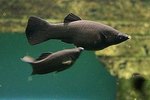
There’s no concrete way to determine if a triops is pregnant. Instead, make the determination by figuring out your triops’ gender and watching her behavior. If her eggs suddenly disappear from her body, there's a large chance they were fertilized.
Determining a Triops’ Gender
You can determine which triops are males by looking at their shields. Males have a flat, round shield. Females can be instantly determined by the eggs they carry around their legs. Triops may also be hermaphrodites. Only some hermaphrodites are capable of creating life. These life-creating hermaphrodites can be determined by the egg sacs attached to their undersides. You can assume that eggs have been fertilized if you have hermaphrodites or males and females in your tank.
How to Determine if a Female Triops is Pregnant
Triops do not become pregnant, but rather lay eggs. Monitor your triops regularly to determine when new ones will be born. Wait for the eggs around the hermaphrodites’ and female’s legs to disappear. This means the eggs were fertilized and the mother attached the egg to something in the tank or dropped them in the substrate. Depending on her size, the triops will produce between 15-60 eggs per brood.
What Are Your Tank Conditions?
Triops require specific tank conditions, in order for eggs to hatch. Known as living fossils, triops have been on the earth an estimated 300 million years. Breeding them isn’t difficult. If it were, they wouldn’t have survived for as long as they have. Still, water must be distilled and conditioned to remove all chlorine and other chemicals. The water’s temperature should be below 72 degrees Fahrenheit. It’s also essential that the tank is placed in very bright, shining light. Triops are sensitive to pH balances, although these balances vary depending on the triops species. Ask your pet store or private dealer which pH balance is optimal for your species.
Diapause Confuses Breeding
Diapause is a rare phenomenon in which eggs stop their growth. This is how triops survived, even when the dinosaurs went extinct. This incredible ability suspends the fertilized egg. Essentially it dies, because all cell growth halts. Then, when environmental conditions are favorable again, the cells burst back to life and the triops live. It isn’t likely that much diapause will take place in your tank, unless you’re severely neglecting the tank, leading to truly unlivable conditions. If short-term diapause occurs, make sure the tank isn’t too cold. Also, make sure you’re avoiding chemicals, as chemicals can destroy the balance of a tank and suspend the hatching process. If you suspect your triops are pregnant, or rather their eggs are fertilized, but those eggs don’t hatch, it could be that they’re in a state of diapause. Work on bringing the tank to optimal hatching conditions to end the diapause.
Beware of Overbreeding
It’s important to understand that triops will breed and multiply quickly. Around 8 days old, a triops will reach adulthood and begin breeding. Those eggs will gestate quickly, hatch in just a couple days and then begin breeding themselves. Triops life spans are only a couple months, so you may enjoy this constant cycle of life. If your tank becomes overrun with triops, you’ll begin to notice that the larger ones are feeding on the smaller ones. It will also be much more difficult to determine which triops are pregnant and which are carrying unfertilized eggs. You can avoid this common pitfall by breeding triops in a separate tank.
References
Photo Credits
-
Seiya Kawamoto/Photodisc/Getty Images
Writer Bio
Caryn Anderson combines extensive behind-the-scenes writing experience with her passion for all things food, fashion, garden and travel. Bitten by the travel bug at the age of 15 after a trip to Europe, Anderson fostered her love of style and fashion while living in New York City and earning her degree at New York University.


